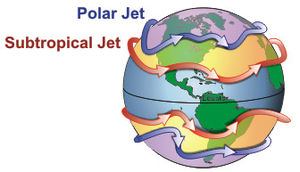Jet Stream

Jet Streams are fast flowing, narrow air currents found in the atmospheres of some planets, including Earth.
The main jet streams are located near the tropopause, the transition between the troposphere (where temperature decreases with altitude) and the stratosphere (where temperature increases with altitude).
After the 1883 eruption of the Krakatoa volcano, weather watchers tracked and mapped the effects on the sky over several years. They labelled the phenomenon the "equatorial smoke stream". In the 1920s, a Japanese meteorologist, Wasaburo Oishi, detected the jet stream from a site near Mount Fuji. He tracked pilot balloons, also known as pibals (balloons used to determine upper level winds), as they rose into the atmosphere. Oishi's work largely went unnoticed outside Japan.
The major jet streams on Earth are westerly winds (flowing west to east). Their paths typically have a meandering shape; jet streams may start, stop, split into two or more parts, combine into one stream, or flow in various directions including the opposite direction of most of the jet. The strongest jet streams are the Polar jets, at around 7-12 km (23,000-39,000 ft) above sea level, and the higher and somewhat weaker Subtropical jets at around 10-16 km (33,000-52,000 ft).
The Northern Hemisphere and the Southern Hemisphere each have both a polar jet and a subtropical jet. The northern hemisphere polar jet flows over the middle to northern latitudes of North America, Europe, and Asia and their intervening oceans, while the southern hemisphere polar jet mostly circles Antarctica all year round.
Jet streams are caused by a combination of a planet's rotation on its axis and atmospheric heating (by solar radiation and, on some planets other than Earth, internal heat). Jet streams form near boundaries of adjacent air masses with significant differences in temperature, such as the polar region and the warmer air towards the equator.
Meteorologists use the location of some of the jet streams as an aid in weather forecasting. The main commercial relevance of the jet streams is in air travel, as flight time can be dramatically affected by either flying with the flow or against the flow of a jet stream. Clear-air turbulence, a potential hazard to aircraft passenger safety, often is found in a jet stream's vicinity. One future benefit of jet streams could be to power airborne wind turbines.
Other jets also exist. During the northern hemisphere summer, easterly jets can form in tropical regions, typically in a region where dry air encounters more humid air at high altitudes. Low-level jets also are typical of various regions such as the central United States.
In 1942 Japan launched 9.300 hydrogen balloons with a load varying from a 12-kilogram incendiary to one 15 kg antipersonnel bomb and four 5 kg incendiary devices attached. They were designed as a cheap weapon intended to make use of the jet stream over the Pacific Ocean and wreak havoc on Canadian and American cities, forests, and farmland. The balloons were relatively ineffective as weapons.

